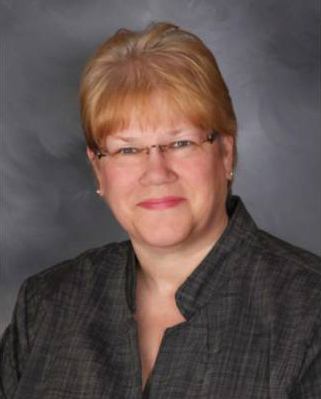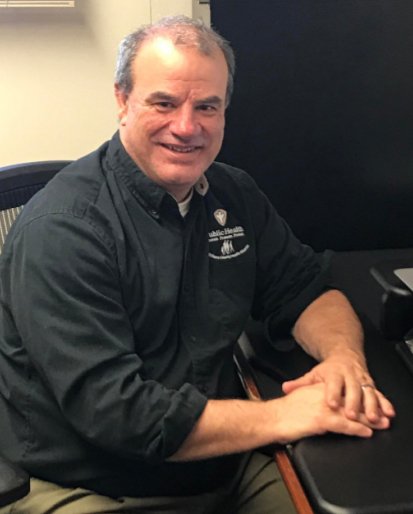Health care executives instruct BGSU students, lead in the field during pandemic
Henry County Hospital CEO, Williams County Health Commissioner lead by example in classroom
By Bob Cunningham ’18
Sometimes, the greatest lesson can come from real-life experience — even living through a pandemic.
Bowling Green State University students in the College of Health and Human Services (HHS) had a front-row seat in the spring semester to two adjunct instructors who have more than 70 years of health care experience combined.
 Kim Bordenkircher, chief executive officer (CEO) of Henry County Hospital in Napoleon, Ohio, taught Issues in Health Care Administration; and Jim Watkins, Health Commissioner of Williams County Combined Health District in Montpelier, Ohio, was the instructor for Public Health and Sanitation.
Kim Bordenkircher, chief executive officer (CEO) of Henry County Hospital in Napoleon, Ohio, taught Issues in Health Care Administration; and Jim Watkins, Health Commissioner of Williams County Combined Health District in Montpelier, Ohio, was the instructor for Public Health and Sanitation.
“The COVID-19 pandemic had to be a pretty anxiety-producing experience for the students,” Bordenkircher said. “Many of my students already work in health care in some capacity, so all of their lives have been uprooted. So, one of the things I did with my discussion posts was flip it around — a reverse discussion post, if you will — and I had the students ask me questions about COVID-19. Any question at all, whether it was how the hospital preparing, questions about the virus itself or what was happening in the news, I answered them all. It was amazing to me the variety of questions they asked me. Honestly, I think the students appreciated that.”
The online discussion also helped Bordenkircher, who has taught at BGSU for six years, take care of the 300 employees at the hospital.
“There were some questions they asked that surprised me and I turned right around and made sure I was answering those same questions for my own staff,” she said. “Part of being a leader is being an educator, so working at the hospital and working at the University, both of those jobs help each other — they have a reciprocal relationship.
and made sure I was answering those same questions for my own staff,” she said. “Part of being a leader is being an educator, so working at the hospital and working at the University, both of those jobs help each other — they have a reciprocal relationship.
“I also want to educate my staff on how they can make good decisions in their personal lives because their ability to manage their exposure to COVID-19 in the community helps make sure that I have a healthy staff at the hospital, which is important to me.”
For Watkins, the experience helped him prepare future students for health crises.
“I hope I am able to bring some context to the subjects covered by sharing real-world experiences of the concepts being taught,” he said. “Unfortunately, we had already completed the portion on emergency preparedness, which would have been a perfect real-life situation to work through. Prior to the end of face-to-face instruction, we did have some discussion on the situation as it was unfolding. In the future, there will be a great number of real-life situations about COVID-19 that I will be able to share with students.”
Bordenkircher began her career in 1980 at Barberton (Ohio) Citizens Hospital as a staff nurse on a medical surgical unit. In 1998, she became the chief nursing officer at Henry Country Hospital and then then CEO in 1999. She provides guidance, support and direction to the staff of the hospital and oversees the overall provision of quality patient care and operationalizes the hospital’s mission, vision and values for the patients, employees and community.
“Being a hospital CEO is a very demanding job as I am responsible for an organization that’s open 24 hours a day, seven days a week and 365 days of the year,” Bordenkircher said. “Hospital staff are used to taking care of infectious patients and are used to being on the front lines, but this was even more emphasized because at the beginning there was so little we knew about the virus. It’s been an interesting and educational experience. I get the opportunity to work with people who, honestly, are heroes all the time.”
In turn, the students also help keep her mind crisp and informed.
“The book might talk about a theory or a concept that seems pretty academic, but I can tell a story from my experience at the hospital that highlights why that’s important or highlights what can go wrong if that concept isn’t followed,” Bordenkircher said. “Because I have worked in health care for 40 years, I have stories about just about anything. Sometimes the book or a PowerPoint isn’t very memorable for students, but they can remember a story — and I have tons of them.
“The reason I teach is because I love the students and teaching at BGSU makes me a better CEO, so I really appreciate the experience.”
Watkins started at the Williams County Health Department in 1986 as an environmental health specialist and served as director of environmental health until 2004. After a brief stint working in health care education in Washington state, he returned to Ohio in 2005 to work as an environmental health specialist to investigate contaminated wells at South Bass Island in Lake Erie related to the water borne outbreak at Put-in-Bay. He has served as health commissioner since 2006. Watkins has a Master of Public Health from the Northwest Consortium for Public Health, a joint effort of BGSU and the University of Toledo.
“We serve as the chief health strategist for the local community and are looked upon to keep the community safe,” said Watkins, who has taught at BGSU since 2016. “Before COVID-19, as a department we provided immunizations every day. Inspectors were mainly out in the field conducting routine inspections of restaurants and other facilities and health educators were working with schools to provide educational programs to children. We also were meeting with partners to advance community health improvement goals and, as always, preparing for possibility of a health crises.
“Today, we have been able to bring some of those services back to the community, but the majority of our efforts remain focused on COVID-19. Many programs such as WIC (Women, Infants, Children), immunizations, birth and death certificates operate under very modified conditions.”
Bordenkircher said she works closely with the Henry County Health Department on helping decide what community events are appropriate to hold while keeping the community safe. Her employees also need to help by being role models.
“While I can’t enforce employees to wear their masks in public, as health care workers, we need to be leaders in the community,” she said. “As role models, we need to wear masks and use social distancing in public because it’s for everybody’s safety.”
Updated: 05/28/2020 11:03AM
